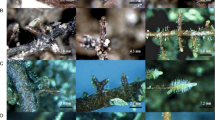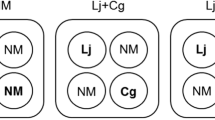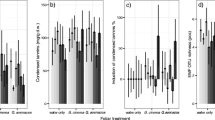Abstract
The effect of inoculating seedlings of Eucalyptus grandis, Allocasuarina littoralis and Casuarina equisetifolia with two isolates of Pisolithus and two isolates of Scleroderma from under eucalypts was examined in a glasshouse trial. Ectomycorrhizas formed extensively on Eucalyptus (23–46% fine roots ectomycorrhizal) and Allocasuarina (18–51% fine roots ectomycorrhizal). On Casuarina, the fungi were either unable to colonize the rhizosphere (one isolate of Pisolithus), or sheathed roots, resembling ectomycorrhizas, formed on 1–2% of the fine roots. Colonization of roots by one isolate of Scleroderma resulted in the death of Casuarina seedlings. Inoculation with fungi increased shoot dry weight by up to a factor of 32 (Eucalyptus), 4 (Allocasuarina) and 3 (Casuarina). Ectomycorrhizas formed in associations with Eucalyptus and Allocasuarina had fully differentiated mantles and Hartig nets in which the host and fungal cells were linked by an extensive fibrillar matrix. Sheathed roots in Casuarina lacked a Hartig net, and the epidermis showed a hypersensitive reaction resulting in wall thickening and cell death. The sheaths are described as mantles since the density and arrangement of the hyphae in the sheaths was similar to that in mantles of the eucalypt ectomycorrhizas. The intercellular carbohydrate matrix was not produced in the Casuarina mantle in association with Pisolithus, hence the mantle was not cemented to the root. These structures differ from poorly compatible associations described previously for Pisolithus and Eucalyptus. The anatomical data indicate that ectomycorrhizal assessment based on surface morphological features may be misleading in ecological studies because compatible and incompatible associations may not be distinguishable.
Similar content being viewed by others
References
Bougher NL, Grove TS, Malajczuk N (1990a) Growth and phosphorus acquisition of karri (Eucalyptus diversicolor F. Muell.) seedlings inoculated with ectomycorrhizal fungi in relation to phosphorus supply. New Phytol 114:77–85
Bougher NL, Dell B, Malajczuk N (1990b) Growth and root structure of Eucalyptus, Allocasuarina and Casuarina seedlings inoculated with ectomycorrhizal fungi. In: Allen MR, Williams SE (eds) Proceedings of the 8th North American Conference on Mycorrhizae, 5–8 September 1990, Jackson, Wyoming. University of Wyoming, Jackson, Wyo, p 32
Burgess T, Dell B, Malajczuk N (1994) Variation in development, infectivity and growth stimulation of 20 isolates of Pisolithus inoculated onto Eucalyptus grandis W. Hill ex Maiden. New Phytol (in press)
Duddridge JA (1986) The development and ultrastructure of ectomycorrhizas. IV. Compatible and incompatible interactions between Suillus grevillei (Klotzsch) Sing. and a number of ectomycorrhizal hosts in vitro in the presence of exogenous carbohydrate. New Phytol 103:457–464
Duddridge JA, Read DJ (1984) The development and ultrastructure of ectomycorrhizas. II. Ectomycorrhizal development in pine in vitro. New Phytol 96:575–582
Gardner IC (1986) Mycorrhizae of actinorhizal plants. Mircen J 2:147–160
Horan DP, Chilvers GA, Lapeyrie, FF (1988) Time sequence of infection process in eucalypt ectomycorrhizas. New Phytol 109:451–458
Lei J, Lapeyrie F, Malajczuk N, Dexheimer J (1990) Infectivity of pine and eucalypt isolates of Pisolithus tinctorius (Pers.) Coker & Couch on roots of Eucalyptus urophylla S. T. Blake in vitro. New Phytol 116:115–122
Malajczuk N, Molina R, Trappe JM (1984) Ectomycorrhiza formation in eucalyptus. II. The ultrastructure of compatible and incompatible mycorrhizal fungi and associated roots. New Phytol 96:43–53
Malajczuk N, Dell B, Bougher NL (1987) Ectomycorrhiza formation in Eucalyptus. III. Superficial ectomycorrhizas initiated by Hysterangium and Cortinarius species. New Phytol 105:421–428
Malajczuk N, Lapeyrie F, Garbaye J (1990) Infectivity of pine and eucalypt isolates of Pisolithus tinctorius on roots of Eucalyptus urophylla in vitro. I. Mycorrhizal formation in model systems. New Phytol 114:627–631
Martin F, Hubert JL (1991) Morphological, biochemical and molecular changes during ectomycorrhiza development. Experientia 47:321–331
Reddell P, Bowen GD, Robson AD (1986) Nodulation of Casuarinaceae in relationship to host species and soil properties. Aust J Bot 34:435–444
Rose SL (1980) Mycorrhizal associations of some actinomycete nodulated nitrogen-fixing plants. Can J Bot 58:1449–1454
Theodorou C, Reddell P (1991) In vitro synthesis of ectomycorrhizas on Casuarinaceae with a range of mycorrhizal fungi. New Phytol 118:279–288
Thoen D, Sougoufara B, Dommergues Y (1990) In vitro mycorrhization of Casuarina and Allocasuarina species by Pisolithus isolates. Can J Bot 68:2537–2542
Warcup JH (1980) Ectomycorrhizal associations of Australian indigenous plants. New Phytol 81:531–535
Wong KKY, Fortin JA (1990) Root colonisation and intraspecific mycobiont variation in ectomycorrhiza. Symbiosis 6:191–231
Author information
Authors and Affiliations
Rights and permissions
About this article
Cite this article
Dell, B., Malajczuk, N., Bougher, N.L. et al. Development and function of Pisolithus and Scleroderma ectomycorrhizas formed in vivo with Allocasuarina, Casuarina and Eucalyptus . Mycorrhiza 5, 129–138 (1994). https://doi.org/10.1007/BF00202345
Issue Date:
DOI: https://doi.org/10.1007/BF00202345




